Before beginning any training, it’s critical to warm up your muscles, joints, and nervous system to handle the workout ahead. As a triple jumper, it’s essential to warm up all the joints, ligaments, and muscles of the legs and core while getting your nervous system primed for jumping. In this lesson, Willie Banks shares the triple-jump-specific warm-up drills his athletes do before every training session.






